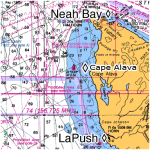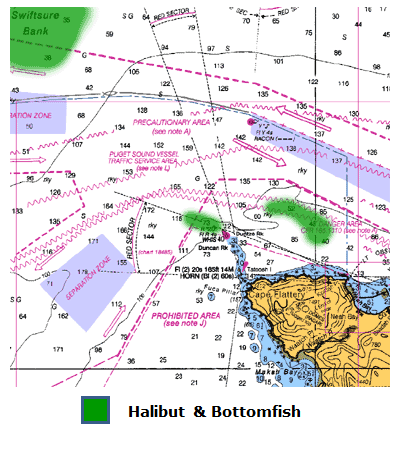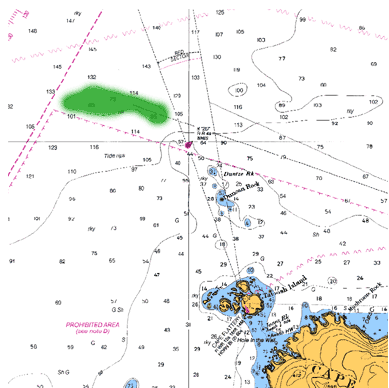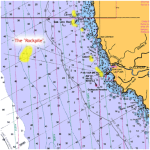Neah Bay & LaPush
 Fishing the the open ocean off Neah Bay and LaPush can be very rewarding. The weather can always be a factor, so fishing out here is pretty much reserved for the late spring and summer time. Both areas are known to produce good numbers of halibut in the late spring and early summer. Salmon fishing in both spots can be nothing short of spectacular, also. All the fish that go to rivers south of here, like the Columbia, pass by these two spots first.
Fishing the the open ocean off Neah Bay and LaPush can be very rewarding. The weather can always be a factor, so fishing out here is pretty much reserved for the late spring and summer time. Both areas are known to produce good numbers of halibut in the late spring and early summer. Salmon fishing in both spots can be nothing short of spectacular, also. All the fish that go to rivers south of here, like the Columbia, pass by these two spots first.
Neah Bay

Neah Bay Halibut
Neah Bay is the state’s best-known and top-producing area for halibut and where the Washington state record 288-pound flatfish was caught.
Ocean halibut fishing is a fun and rewarding challenge. Great memories can be made along with a chance of harvesting some of the best eating fish in the world!

Fishing the inside waters of Area 4B: One of the most popular is the Garbage Dump located just to the west of Neah Bay. This area is close to shore and very popular, as it tends to be less lumpy. You can normally see the dump burning up on the hill making it easy to find fish the 300-325 ft. water. You can back into the current with your motor to slow your drift and give your bait more bottom time.

The next inside spot that has accounted for many halibut is the area just west of Duncan Rock. About halfway between the Canadian boundary line and Duncan Rock the bottom comes up to about 300 ft. You will need to work the tide and wind and hang tough but you can land some nice halibut here if you put in your time. Offshore Locations: The blue water is where most of the halibut action takes place. The most fished areas are Swiftsure, 72 square, and the US or Canadian Blue Dot along with many other locations that reside on secret GPS logs. Swiftsure is the shorter run about 10-14 miles west of Cape Flattery. This is big water and there are NO landmarks out here. You will need a good GPS unit to find these locations. You should also have a VHF radio so if you have a problem you can call the Coast Guard and it will allow you to monitor the weather, which can change quickly on the ocean. If it’s your first trip here take a charter it’s the quick way to see how things work.
Tides: Tides are the key factor when planning a trip to Neah Bay. The less water movement the better the fishing will be, not that you can’t catch halibut on a bigger tide change, it’s just a shorter window and you have to use a lot more lead to stay in contact with the bottom. I look for a day with slow current change; normally the fishing will be good all day. Spreader Bars with large horse herring (purple or black label) are the standard bait for flaties. I rig them with a 20 inches of 50-lb. mono shock leader from a ball bearing swivel to the spreader bar coming from the Tuff Line XP. Hook up the herring whole so it will spin on the leader from the spreader bar. Add enough weight to stay in contact with the bottom and you’re ready to hunt big flat fish. You can also try a little octopus tentacle as it makes great bait when the herring supply runs low. If you have an encounter with a swarm of dogfish it’s time to pull out the artificial jigs. Large jigs with scampi tails can really save the day when the dogs move in.
Dealing with big Halibut: These fish are big and powerful, you don’t want to drag a big halibut onboard your boat without subduing it first… it can do serious damage to your boat not to mention your body! For a real large halibut I start by harpooning it with the line from the detachable head on the harpoon hooked up about 20 ft. down the line to a large Scotsman float. Leave about 30 feet of line after the float then attach that to the boat cleat. After harpooning let the Halibut wear itself out pulling on the float. I then club it a few times, drag it in the boat and hog tie the tail to the head through the gills on the fish. Use gloves, the teeth are sharp. Now the halibut is safe and ready for transport. Then cut the gills and let the fish bleed out. This will also make for a better eating fish.
Limits: Always check the WDFW Regulations for seasons and limits. If you acquire a Canadian license before arriving at Neah Bay you can fish the Canadian side also.
Anglers heading up after May 25th can score the early king salmon opener followed shortly by the summer Coho run.
LaPush
How to get to LaPush
LaPush, Washington is located on the northwest coast of the Olympic Peninsula. From Seattle, the shortest route is the ferry from Edmonds to Kingston. From there, follow the signs to the Hood Canal Bridge. After crossing, continue on (the road flows into Hwy.101) through Sequim and Port Angeles, around Lake Crescent, and just before you get to Forks (1 mile), turn right on Hwy. 110. Continue for 14 miles, wind your way through the small village, and you arrive at the Lapush Marina. The first building on your right is the fuel dock, a colorful mural painted by a Quileute tribal artist marks the building. The dock area follows, and at the end of the three ramps that access the boats, you will find a boat launch. The marina is open from approximately 6:00 a.m. until 5:00 p.m. Recently, the Quileute people have added several cabins for overnight stays, and they have opened a new restaurant located next to the dock area.
Fishing LaPush
 Getting from the harbor to the ocean requires a short boat trip (less than 5 minutes to the ocean) down the tide waters of the Quileute River, which flow on the lee side of James Island. The best part is, the potential for hooking fish begins instantly. This area, at the mouth of the river, offers fish that are staging for their journey up the Quileute and on to one of the three world-famous streams that make up the Quileute system – the Sol Duc, Calawah and Bogachiel. As the summer progresses and freshets begin to signal the transition to fall, the area directly in front of the river on out to the “Q” buoy becomes increasingly fishier.
Getting from the harbor to the ocean requires a short boat trip (less than 5 minutes to the ocean) down the tide waters of the Quileute River, which flow on the lee side of James Island. The best part is, the potential for hooking fish begins instantly. This area, at the mouth of the river, offers fish that are staging for their journey up the Quileute and on to one of the three world-famous streams that make up the Quileute system – the Sol Duc, Calawah and Bogachiel. As the summer progresses and freshets begin to signal the transition to fall, the area directly in front of the river on out to the “Q” buoy becomes increasingly fishier.
Fishing for the last several years has been better than I have seen since the 1970’s. Silver limits are the rule for every boat that ventures out to the “rock pile” (7.5 miles outside the mouth of the river), and the chinook fishing so far this year has been great. Other spots to look for chinook and other species are literally too numerous to mention… every piece of underwater structure and every current rip on the surface can hold fish.
Watch the Weather
As great as the fishing is, be aware that when temperatures are hot inland, the possibility of fog increases on the coast. Anyone fishing here should have a GPS system and the ability to use it accurately. It’s important to “pop” a number dead center at the mouth of the river, another mark at the red entrance buoy (just to the south of the river), and one more number at the “Q” buoy. This will ensure a safe entrance in heavy fog conditions. James Island offers wonderful protection at the entrance of the river, and there really isn’t a “bar crossing” to worry about, unlike other coastal fisheries.
However, one exception exists: on a heavy southwesterly wind, the swell comes directly into the river and in this event, simply do not go fishing. The good news is, this is not the customary wind in fact, during the summer, it is unusual. The prevailing summer winds are west-northwest and these are totally blocked by James Island, making the normal trip to the salt the easiest and quickest on Washington’s coast.
It’s always a good idea to book a trip on a charter boat first, to get the “feel” of the place before you take your own boat out for the first time.
The fishing’s great. What are you waiting for?
How to Fish for Salmon | How to Catch Salmon | How to Fish for Tuna | How to Catch Tuna | How to Fish for Halibut | How to Catch Halibut





